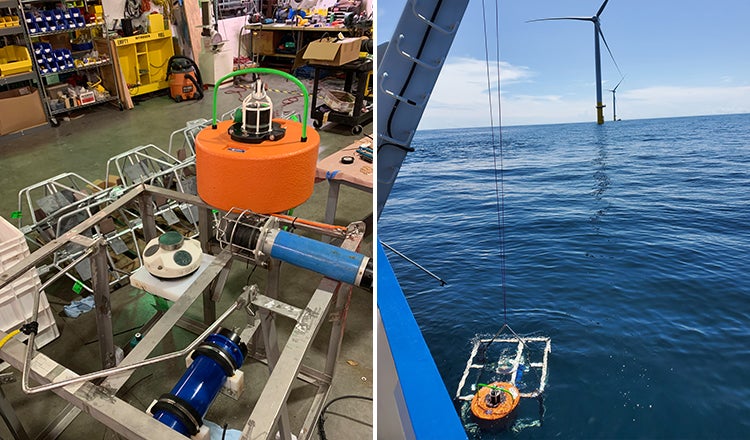
A Deep Dive Into the Aquatic World of Offshore Wind Farms
Expert Environmental Scientists Monitor United States’ First Wind Turbines at Sea
The U.S. East Coast is experiencing a boom in offshore wind farm construction, and HDR is playing a central role. We’re supporting the federal government with real-time environmental monitoring during wind farm construction and operations, which improves our understanding of the potential impacts of these facilities on the marine ecosystem.
To date, two such facilities have been constructed. Block Island Wind Farm, located off Rhode Island, is a pilot facility with five turbines that generate 30 megawatts of power. The Coastal Virginia Offshore Wind pilot project is the second facility constructed in the U.S. It features two turbines that generate 12 megawatts of power. These projects were performed as part of the Real-Time Opportunity for Development Environmental Observations program, sponsored by the Department of Interior’s Bureau of Ocean Energy Management.
HDR's team of marine scientists, led by Anwar Khan, senior program manager, used state-of-the-art monitoring protocols to gather data on underwater and in-air noise propagation, visual impacts, alterations in ocean floor characteristics, benthic community abundance and diversity, and biofouling of the turbine foundations.
“Hundreds of turbines are planned for locations along the East Coast, and the question is: ‘How can this massive underwater infrastructure be built in an environmentally friendly manner?'”
— Anwar Khan, Senior Program Manager
Studying Environmental Stressors, Reducing Risk to Marine Life
Underwater environmental monitoring is inherently challenging due to the extreme and dynamic conditions of marine construction. Pile driving, the most common technique for building turbine foundations at sea, can be very loud and have detrimental effects on marine life.

Documenting Challenges, Tools and Tips for Future Projects
It is important to document lessons learned at such a key milestone. And it is fascinating to learn more about the changing underwater world at the “feet” of these massive turbines. Our monitoring team — including in-house marine biologists, geologists, planners and engineers, and top scientists from regional universities — shares how they solve problems and overcome challenges day to day.
Challenge: Shifting construction schedules. The monitoring team must coordinate closely with the construction team to collect data during pile driving. But in reality, marine construction schedules change at short notice due to a variety of factors.

Solution: Use the right mix of monitoring devices and platforms. The team uses both attended and unattended listening devices (hydrophones) for acoustic data collection. A few days before construction, we place unattended devices, with 4- to 6-week battery power, on the seafloor around the site. These units collect data continuously over extended periods, bracketing the entire construction period with information gathered before and after pile driving and serving as benchmarks for background noise levels.
In addition, attended devices, such as towed arrays and dipped hydrophones, are deployed during construction. This mix of instruments serves as a redundant and comprehensive approach, buffering the unpredictability of construction schedules with valuable, real-time environmental data.
Datasets collected by both types of sensors also provide us with the information we need to assess impacts to wildlife, and determine the effectiveness of mitigation measures used to dampen pile-driving noise (e.g., “bubble curtains”).
Challenge: Rapid and unpredictable changes in marine weather. Weather plays an important role in our work. We need relatively calm conditions to safely collect data.
Solution: Prepare to cut and run. Marine forecasts are usually accurate, but we must always prepare for rapidly worsening and unsafe sea states. Some data collection efforts must be curtailed or completely abandoned to maintain team safety. Hope for the best but prepare for the worst!
Challenge: Risk of equipment failure. Seawater is corrosive, and electricity and seawater do not get along. When we place battery-powered monitoring devices on the seabed for extended periods, there is always a risk of equipment failure, which may result in data loss. The loss is not always apparent until the device is recovered weeks later and inspected in the laboratory.
Solution: Use properly tested, high-quality equipment and collect redundant data (on purpose). Even with thorough pre-deployment equipment checks and inspections, loss of data due to seawater encroachment into monitoring devices isn’t completely avoidable. We deploy multiple devices at a given location to confirm that at least some useful data is collected.
Deploying redundant monitoring equipment is expensive, but protects us and our clients in the long term.
Challenge: Deploy remote-sensing instruments over weeks and months, risking equipment loss. Devices placed on the seafloor can be dredged up by fishing trawlers, dragged by passing ships, or dislodged by storms. But data collection over these time scales is often necessary to obtain meaningful results.

Solution: Minimize equipment loss risk through effective planning and management. We secure acoustic and seismic monitoring sensors on customized, heavy moorings — strategically placing them at predetermined locations with specially equipped research vessels. We engage the most experienced personnel who avoid areas known to be active fishing grounds and designated navigation channels whenever possible. Deployment is conducted during calm weather periods to avoid damage from accidental mishandling in rough seas.
Going Forward
With two offshore wind farms constructed to date, and more than a dozen in the planning stages, the U.S. industry is in its infancy with potential for rapid expansion.
The work our marine scientists are doing supports BOEM in developing policy and guidance. We have been awarded a follow-on contract to conduct similar data collection at the next two facilities planned for construction in the U.S.: South Fork Wind Farm, offshore Rhode Island; and Vineyard Wind 1, offshore Massachusetts. We are at the forefront of this very important, emerging renewable energy source.




